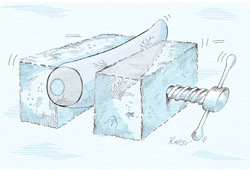Titan boat disaster, during the June 2023 expedition. to the wreck of the Titanic, killed five people, including the head of the OceanGate company organizing the expeditions, a billionaire captivated by the idea of plunging to such colossal depths (4,000 meters) to reach the legendary liner. This is an example of how the complexity of physical phenomena and the technical answer to them exceeds the imagination of people affected by the hubris of “discoverers” (truth be told, there was nothing left to discover here). Those willing to travel were wowed by the quality of the materials used in Titan’s construction – steel, titanium, carbon fiber, kevlar. The basic parameters of these materials are indeed record-breaking. Ultra-high-strength steel has a tensile strength of approx. 1500 MPa, yield strength – 1100 MPa. The latest titanium alloy – 895 and 828 MPa respectively, carbon fiber – no less than 2500 MPa in tension, Kevlar (single fiber) – 3620 MPa. The pressure at the bottom next to the Titanic is approx. 40 MPa. Is it impressive? Unfortunately, it was probably most impressive for the enthusiasts who paid hundreds of thousands of USD for the expedition.
The above figures are for simple stretching. But Titan’s banana-like design raises doubts. As is well known, the static quantities (forces perpendicular and tangential to the section, as well as the moments of force, and therefore the stresses they cause) depend on the geometry of the structure. The complex state of stress (different directions of tension, shear, bending, torsion of the section) according to the Huber-Mises-Hencke hypothesis, and the combination of such different materials also plays a role here. For reliable calculations, one would have to use advanced software, strain gauges, a high-pressure chamber, at least for model tests (with results convertible to real conditions). As the company’s chief executive himself announced, the relevant tests were not carried out because the design was “too advanced” and manned tests were “impossible to carry out.” How, then, did as many as 19 dives into the wreck succeed? A remark by an eminent professional from the Maritime Academy in Szczecin, Robert Dmochowski, may help with the answer: In addition to the monstrous pressure, there are also stresses resulting from its changes. They are the cause of phenomena known as fatigue stresses. They are characterized by stealth and deceitfulness. The main source of fatigue was cruising to and from the depths, further reinforced by the vibratory action of the engines mounted almost directly on the structure of the crew chamber. As a result of loading, repeatedly cycled, structural elements often fail at stresses well below the ad hoc tensile strength of a given material determined from static tests. Add the fact that the kevlar used to coat the boat is degraded by UV exposure, and therefore aging, which is also a kind of fatigue. And the boat had been exposed to the sun for 5 years. This is an attempt at a technical answer. And another answer is the strength of the Titanic legend as cemented by James Cameron’s film. The Titanic tragedy brought the Titan tragedy.
Zygmunt Jazukiewicz





